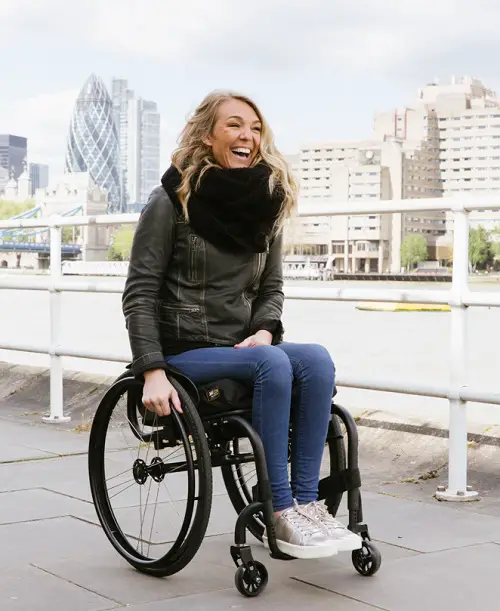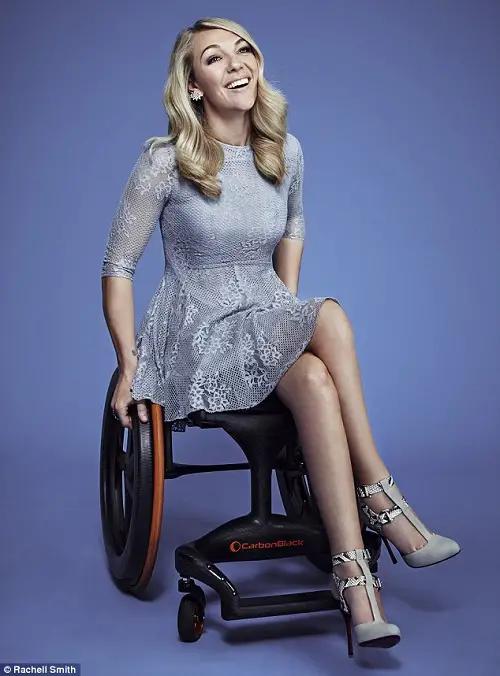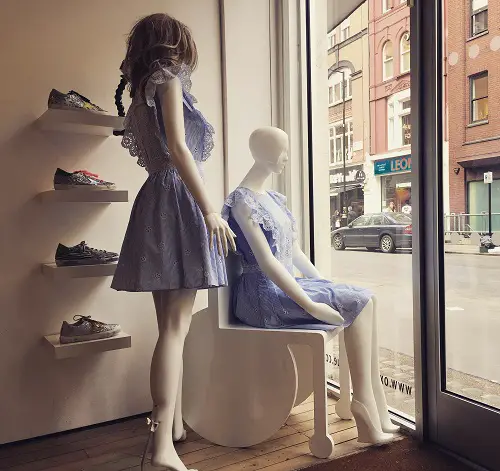
Sophie Morgan on being a presenter, artist and disability campaigner
Sophie Morgan is a British journalist, TV presenter, artist and disability activist. She became a wheelchair user in 2003 after suffering a T6 spinal cord injury following a road traffic accident. Our writer, Emma Purcell, spoke to Sophie about her varied career to date, her campaigning work, and what life is like for her with a physical disability.
Sophie Morgan first came into the media spotlight when she appeared in a BBC documentary called Beyond Boundaries, where 11 people with different disabilities, including Adde Adepitan, trekked across the Nicaraguan jungle.
Her notoriety increased when she featured in Britain’s Missing Top Model, where eight disabled models battled it out to be crowned the winner. Although she didn’t win the show, she’s gone on to model for Stella McCartney’s Adidas capsule collection called My 2012 and presented a number of high-profile TV shows, including the Paralympics and various documentaries for the BBC and Channel 4.
But Sophie isn’t just a television personality. She also does a lot of disability campaigning and supports multiple charities. A decade ago, she created the Mannequal, a wheelchair for a mannequin to be used in high street clothing stores. Her aim was to change perceptions of disability in the fashion and retail industries.

Prior to Sophie’s accident, she was aiming to study law at university. However, after she became paraplegic, she decided to study art and, alongside her other work, is a professional artist who does a variety of drawings and oil paintings.
Read on to find out more about the many different facets of Sophie’s varied life and career so far, as well as watch her in action on some incredible adventures…
Sophie Morgan’s accident and disability
What was it like having to adapt to being a wheelchair user after your accident?
I suffered pretty severe injuries in my crash. Not only was my spine damaged, but my face was practically crushed. It meant that adapting to my new situation took some time as the damage sunk in.
Eventually, I adapted by focusing solely on the things that I could still do, as opposed to the things that I had lost or could no longer do. It is a coping mechanism that I still use to this day. I also pulled as many friends around me as I possibly could.
What is the hardest thing about being disabled, as well as the greatest?
The hardest thing is not being able to be the full and whole person that I am in my mind, and in other people’s minds. But the greatest thing is seeing the world from a unique position. It means that every day I am grateful for what I have. That can be a rare thing.
What was it like taking part in Beyond Boundaries, trekking across Nicaragua? And were you disappointed when you couldn’t complete the journey?
It was one of the craziest experiences of my life. I really came face-to-face with the extent of my disability and paralysis. That meant it was life-changing for me.
It was the first time that I realised that no matter what attitude I have, if my environment isn’t accessible, then I am utterly disabled. I was so gutted that I become sick and had to come home early.
Sophie Morgan’s time as a model

What was your experience of appearing in Britain’s Missing Top Model like?
I didn’t really enjoy the experience at all. It was a strange environment and I didn’t really know how to conduct myself. I struggled with the fact that as a visual competition it wasn’t a level playing field and the politics in the house were difficult to manage.
I didn’t enjoy how much the program was edited either, and I didn’t like watching myself. My views were too strong and I don’t think I was kind enough at times. But as a subject, I found it fascinating. It has inspired so much of the work I do today in terms of improving representation. It was a learning curve for sure.
Did you enjoy modelling for Stella McCartney’s Adidas My 2012 sportswear campaign?
That was a real joy. There was no fuss made over the fact that I have a visual disability. I was just another ‘model’ in the campaign. That’s how true equality is achieved.
How was the launch of your Mannequal and has it achieved the aim of changing perceptions of disability in fashion retail?
I designed the chair more than 10 years ago, but struggled to get traction. Now that the world has changed and attitudes and perceptions of disability have improved, I am slowly getting there.

I can’t talk much about it just yet, but I’m working with some major retailers currently. So, in answer to your question, I hope to achieve the change I’ve dreamed of VERY soon!
Sophie Morgan and presenting
How did you get offered to present the Paralympic Games in London 2012 and Rio 2016?
I was called in for an audition with a lot of other potential presenters. We were rigorously tested and, in the end, I was lucky enough to get the role.
It was the most incredible experience, and still, to this day, I can’t believe I got the job. Live TV presenting on one of the most widely watched sports events. It was a dream!
What was your highlight of presenting the Paralympics?
It was all a huge blur, to be honest. I was so nervous. But if I had to pick one moment, it would be the time I had the entire GB Para-equestrian team in the studio where we got to have a chat. They are extraordinary athletes.
Which Paralympic Games, London or Rio, did you enjoy presenting the most and why?
I only had a tiny role in the London Paralympics, whereas in Rio I fronted the afternoon show. So for me, Rio was the big deal. My co-presenter, JJ, and I covered the afternoon slot live from 4 until 7pm every day. It was incredible.
It was also very scary, but so magical. We were definitely thrown in the deep end. I’m also pleased to say that I will be presenting the 2020 Paralympics in Tokyo next year. It’s going to be amazing.
You’ve been involved in numerous documentaries over the years. Which one was your most interesting and inspiring to film?
My absolute favourite was making a documentary for Channel 4 News about the disproportionate number of indigenous boys in prison on Australia. I spent a month in the outback and we really uncovered some extraordinary stories. It was amazing to get to travel so far for work, too.
Do you have any future plans to film more documentaries this year?
I’ve just finished filming a six-part series for Channel 4, which will air in May. I can’t talk about the others just yet.
I’ve also just been invited to join the content board of Ofcom, an organisation that monitors and decides what is and isn’t permitted on TV and radio. It’s an amazing privilege. The role invites board members to get involved in regulation. It’s so interesting!
Sophie Morgan and travelling
Being a passionate traveller, you’ve been to various places across the globe. What have been your best and worst trips?
Every trip is different. To be honest, it is hard to say which is best or worst. I’ve learnt something from every adventure I have had.
Filming the TV show The World’s Worst Place to be Disabled? for the BBC in 2015 in Ghana was pretty bad though. I was very relieved to get home after witnessing so much discrimination toward disabled people and experiencing it first hand. I was very glad to get back to the UK.
One of the highlights of my life has been going skiing again for the first time since my accident. I went with my family to France last year and I felt on top of the world!
I have heard that you’re planning on embarking on an around the world challenge using a trike. Is this still in the pipeline and has planning begun?
This is very much in the pipeline and planning is already underway. I can’t wait to tell you more about it.
Sophie Morgan as an artist
Why did you choose to study art rather than law at university?
My injury changed my perspective on life and I decided that I just wanted to study something I loved and made me happy. I loved art school and can’t imagine life without art.
Describe the kind of art you create?
I do a variety of drawings and paintings. I make oil paintings, but I also I do pencil portraits, which are commissioned by people for themselves or loved ones. I sell line drawings, which is artworks inspired by my imagination, memory or fantasy.
I also make ‘love lines’, which are bespoke drawings inspired by moments of love! People send in photos for me to work from. I love it!
You can buy Sophie Morgan’s Love Line drawings or commission her on her dedicated website.
What has been your favourite piece of artwork you’ve created so far?
This piece was amazing to paint. It is of me swimming – something I love to do.

Sophie Morgan the disability campaigner
Tell us more about the charities you support to help create change for disabled people across the world?
I’m a patron of Scope, which is incredible in the work it does to make the UK a more equal society for people with disabilities.
I have joined with Human Rights Watch to support the vital work it does in raising awareness of the breaches in human rights that so many disabled people face on a daily basis around the world.
I also support Lumos in its efforts to end institutionalisation of disabled children
You recently became an ambassador for Leonard Cheshire and featured in a BBC Radio 4’s associated appeal raising awareness of disabled children unable to access schools in Africa. How was the experience?
It was a really successful campaign and I’m so proud to be part of so many different charities. Leonard Cheshire does some very important work overseas to support disabled people. I hope that the part I play in it will raise awareness of the impact and reach it achieves.
If you could choose one favourite area of your career – journalism, TV presenting, disability campaigning or art – which would it be and why?
I can’t choose, which is why I don’t! I love everything I do. TV presenting is wonderful because I get to travel and have a voice. Art is my passion and is very cathartic.
Campaigning is also so important – I believe we have to create the changes we want to see in the world. I always want to mix it up!
What advice would you give to other disabled people seeking a career in the creative industries?
Follow your passion and make sure you find a mentor who can support you in your efforts. Like any industry, a thick skin helps.
To find out more about Sophie Morgan and her mix of creative work, visit her website. You can also follow her on:
- Facebook/SophMorg
- Twitter @Sophmorgtv
- Sophie Morgan Instagram @Sophimorg
By Emma Purcell
More on Disability Horizons…